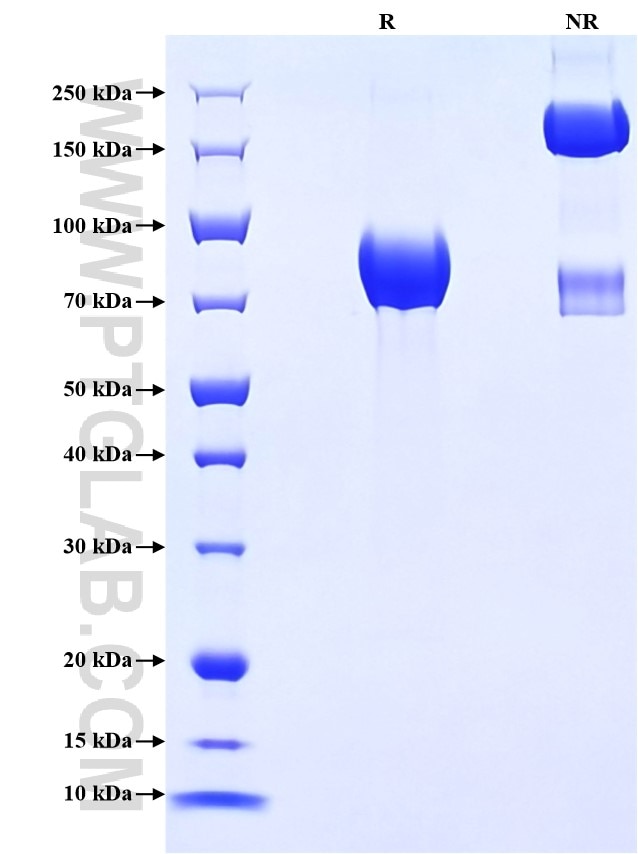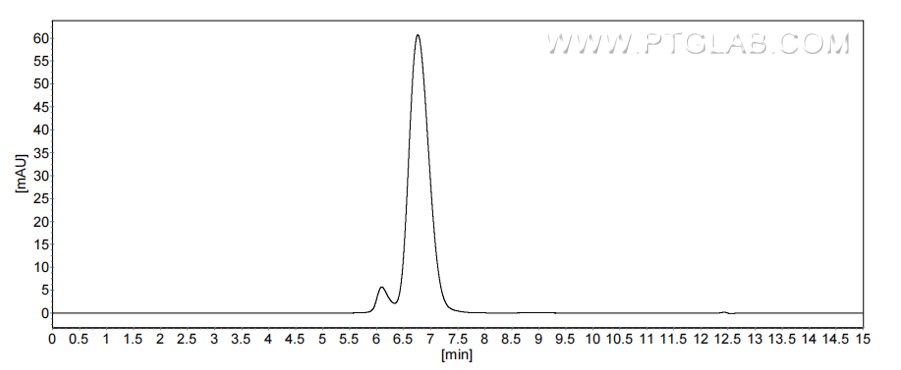Recombinant Human LILRB3/CD85a protein (rFc Tag) (HPLC verified)
Species
Human
Purity
>90 %, SDS-PAGE
>90%, SEC-HPLC
Tag
rFc Tag
Activity
not tested
Cat no : Eg2084
Validation Data Gallery
Product Information
| Purity | >90 %, SDS-PAGE >90%, SEC-HPLC |
| Endotoxin | <0.1 EU/μg protein, LAL method |
| Activity |
Not tested |
| Expression | HEK293-derived Human LILRB3 protein Gly24-Glu443 (Accession# AAI04994.1) with a rabbit IgG Fc tag at the C-terminus. |
| GeneID | 11025 |
| Accession | AAI04994.1 |
| PredictedSize | 72.4 kDa |
| SDS-PAGE | 70-100 kDa, reducing (R) conditions |
| Formulation | Lyophilized from 0.22 μm filtered solution in PBS, pH 7.4. Normally 5% trehalose and 5% mannitol are added as protectants before lyophilization. |
| Reconstitution | Briefly centrifuge the tube before opening. Reconstitute at 0.1-0.5 mg/mL in sterile water. |
| Storage Conditions |
It is recommended that the protein be aliquoted for optimal storage. Avoid repeated freeze-thaw cycles.
|
| Shipping | The product is shipped at ambient temperature. Upon receipt, store it immediately at the recommended temperature. |
Background
The leukocyte immunoglobulin-like receptors (LIRs, also known as ILTs, CD85, and LILRs) comprise a family of related immunoregulatory receptors encoded within the leukocyte receptor cluster (LRC) at chromosomal region 19q13.4. LIRs are transmembrane proteins containing either two or four extracellular immunoglobulin domains, and have diverse functions, including the regulation of inflammation, immune tolerance, cell differentiation and nervous system plasticity. LILRB3, also known as ILT-5 or CD85a, belongs to the subfamily B class of LIR receptors which contain two or four extracellular immunoglobulin domains, a transmembrane domain, and two to four cytoplasmic immunoreceptor tyrosine-based inhibitory motifs (ITIMs). LILRB3 is found on the surface of a variety of cell types including monocytes/macrophages, granulocytes, NK cells and some T cells. It binds to MHC class I molecules and transduces a negative signal that inhibits stimulation of an immune response. LILRB3 has been reported as a myeloid cell checkpoint that elicits profound immunomodulation.
References:
1. N T Young, et al. (2001). Immunogenetics. 53(4):270-8. 2. Lee I Garner, et al. (2006). Protein Expr Purif. 47(2):490-7. 3. Kouyuki Hirayasu, et al. (2015). J Hum Genet. 60(11):703-8. 4. Muchaala Yeboah, et al. (2020). JCI Insight. 5(18):e141593.


